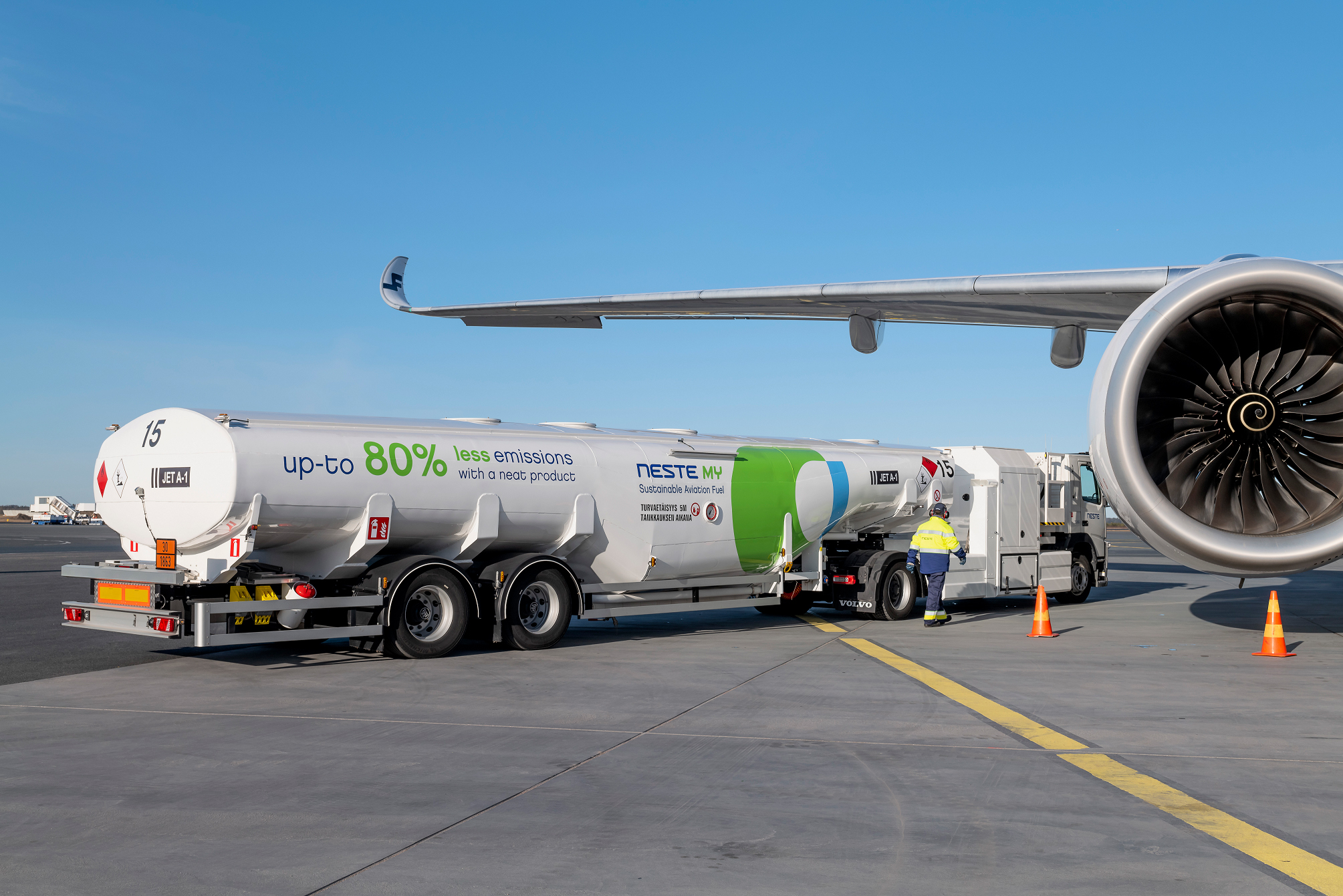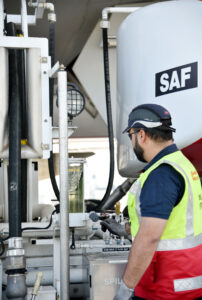
If the aviation industry is serious about reaching net zero by 2050, SAF will have a sizable role to play in that transition. However, customers will also need to play their parts by flocking to airlines offering more sustainable transit options. Because, as we’ve seen, making airlines go green depends on another kind of green: the almighty dollar.
Asia’s airlines are renowned for their luxury, but considerably less so for their sustainability. Airlines like Hong Kong’s Cathay Pacific and Dubai’s Emirates may offer award-winning business class accommodations – complete with everything from orthopedic mattresses to free-flowing champagne – but the airlines have been slow to make their infrastructures more environmentally friendly.

SAF in Emirates.
However, a recent spate of deals is driving the use of sustainable aviation fuels (SAF) in airlines across the Asian continent. These alternative fuels are produced from a mixture of cooking oil and agricultural waste. It’s estimated that SAF implementation could contribute around 65 percent of the emissions reductions needed for aviation to reach net-zero by 2050. Unfortunately, these low-carbon alternatives to jet fuel come with a heavy price tag and significant scalability issues.
Exactly how far away are airlines from wide scale implementation of SAF, and how do they compare to those being developed elsewhere, particularly in the United States?
Singapore leads the way in Asia
Singapore is already known as one of the most environmentally forward countries in Asia, with its sprawling botanic gardens and its extensive public transit infrastructure. And now, in efforts to green-up its aviation transit networks, Singapore Airlines is currently undertaking a one year pilot program testing the feasibility of SAF. Under this pilot, Finnish oil producer Neste is providing the airline with 1,000 tonnes of SAF blended with refined jet fuel sourced from Exxon‘s facilities in Singapore.
Recently Singapore Transport Minister S. Iswaran also announced that the Civil Aviation Authority of Singapore (CAAS) is examining the possibility of implementing SAF mandates and incentives within the Singapore Sustainable Air Hub Blueprint, which is set to be published this year. If SAF mandates are implemented, we can expect to see the pilot implemented on a larger, more permanent scale.
Elsewhere on the continent, India has announced a proposal to mandate that its domestic carriers each use at least one percent SAF. While that amount may sound measly, consider the number of airlines and domestic travelers in India, and the actual number adds up significantly. Still, it won’t be enough to reach net zero.
Stacking up globally
Globally, the U.S. carrier United Airlines is by far the biggest purchaser of SAF with an offtake volume of more than 10.5 billion liters. Delta ranked second with over 3.8 billion liters.
It’s worth noting many U.S. airlines advancements in SAF have only come in the last few years. World Energy, a U.S. company, operated the world’s first SAF plant in Los Angeles but is now building a new factory in Houston. In other words, the supply was already there. The jump in demand by airlines only occurred following the enactment of the Inflation Reduction Act, which offered tax credits for cleaner jet fuel, along with soaring fuel prices.
So U.S. airlines are currently adopting SAF at a rapid rate, spurred by policy incentives and an abundant supply. But Asian airlines are facing legal mandates for SAF implementation, as opposed to just economic incentives. And Europe is currently grappling with its own SAF regulations, seeking to mandate 70 percent SAF for EU carriers by 2050. It should be noted that these new sustainable fuels, just like forthcoming electric aircraft, still must comply with aviation’s mandatory safety standards such as ARP4754A/B for engines and fuel systems; this ensures continued safety.
If the aviation industry is serious about reaching net zero by 2050, SAF will have a sizable role to play in that transition. However, customers will also need to play their parts by flocking to airlines offering more sustainable transit options. Because, as we’ve seen, making airlines go green depends on another kind of green: the almighty dollar.
Vance Hilderman, is the principal founder/CTO of three of the world’s most significant aviation development/certification companies including TekSci, HighRely, and AFuzion. Hilderman has trained over 31,000 engineers in over 700 aviation companies and 30+ countries. His intellectual property is in use by 70% of the world’s top 300 aviation and systems developers worldwide, and he has employed and personally presided over 500 of the world’s foremost aviation engineers on 300+ projects the past thirty-five years. AFuzion’s solutions are on 90% of the aircraft developed over the past three decades. His latest book, Aviation Development Ecosystem, debuted at #1 on the Aviation category best-seller list.





























































































































































































